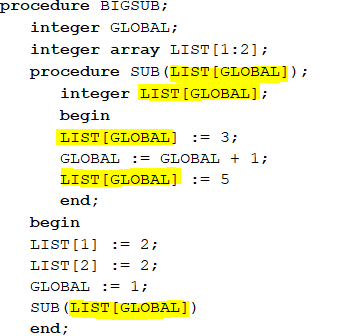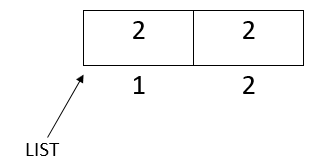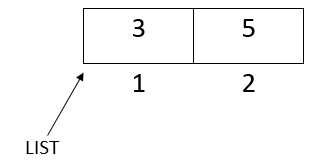Return
to Parameter-Passing Methods
Implementation Methods:
Pass-By-Value (In mode)
Actual parameter (argument) is used to initialize the
formal parameter (parameter).
Implemented by actual data transfer (physically
copy)
It takes a lot of space.
Pass-By-Result (Out mode)
Value determined in subprogram is returned
to actual parameter.
Troubles (page 340)
There can be
an actual parameter collision:
In function call:
sub(p1, p1)
In function definition: there are two different parameter's
names, void sub(int s1, int s2)
s1 --> p1
s2 --> p1
One of them will be overwritten.
Pass-By-Value-Result (In-Out mode)
It is a combination of above two.
Pass-By-Reference (In-Out mode)
No duplicate space
No copying
Access to formal parameters is slow
If only one-way communication is needed, this
is not safe
Allow for creation of aliases
Pass-By-Name (In-Out mode)
The actual parameter is textually substituted
for corresponding formal parameter in all occurrences in the subprogram.
If the actual parameter is a constant, then
this is equivalent to Pass-By-Value
If the actual parameter is a scalar, then
this is equivalent to Pass-By-Reference.
Other methods: formal parameters are
bound to actual values or addresses at the time
of the subprogram call.
This method: formal parameter is bound to
an access method at the time of the subprogram call,
but the actual binding to a value or an address is delayed
until the formal parameter is assigned or referenced.
See the following example from page 364 of second edition:
¡@
procedure BIGSUB;
integer GLOBAL;
integer array
LIST[1:2];
procedure SUB(PARAM);
integer
PARAM;
begin
PARAM
:= 3;
GLOBAL
:= GLOBAL + 1;
PARAM
:= 5
end;
begin
LIST[1] := 2;
LIST[2] := 2;
GLOBAL := 1;
SUB(LIST[GLOBAL])
end; |
 |

 |
After execution, the array LIST has the values
3 and 5.
It is used at compile time by macros in assembly languages and the generic
parameters of the generic subprograms in C++, Java 5.0, and C# 2005


